Anti-Inflammatory Foods Every Kitchen Should Have
Chronic inflammation affects nearly 60% of adults worldwide, contributing to conditions like heart disease, diabetes, and arthritis (source). The immune system is the primary organ system driving inflammation, acting as the body’s defense mechanism. However, early symptoms often go unnoticed, making detection challenging until advanced stages. This subtle progression underscores the importance of proactive dietary choices to support immune health and manage inflammation before it leads to serious complications (source).
1. Blueberries
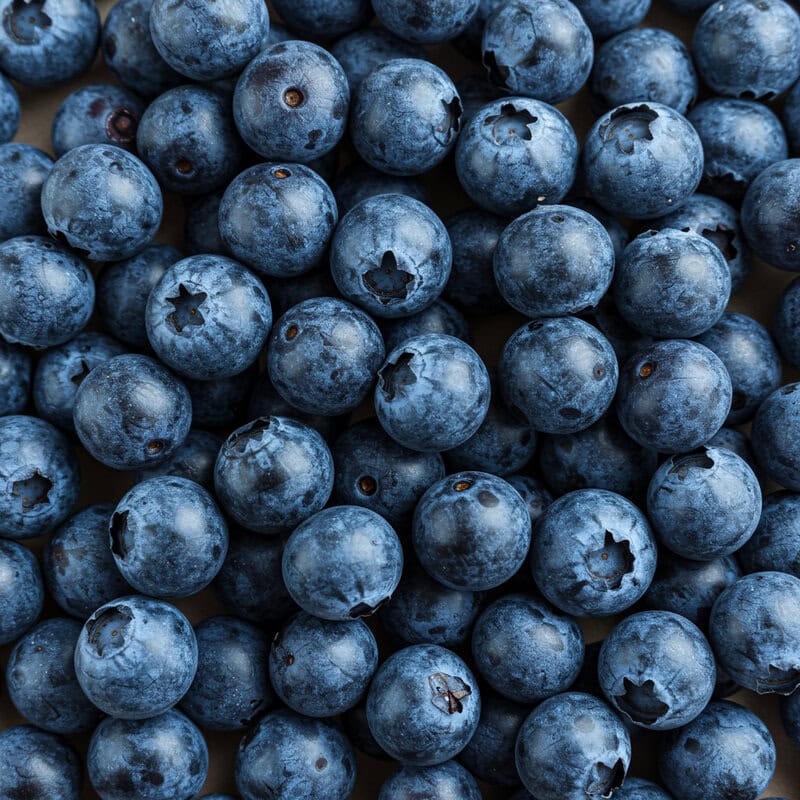
Blueberries are renowned for their potent anti-inflammatory properties, primarily due to their high content of anthocyanins, a type of flavonoid responsible for their deep blue color. Anthocyanins act as antioxidants, neutralizing free radicals and reducing oxidative stress that triggers inflammation in the body (source). Research has shown that blueberries contain higher levels of anthocyanins compared to other commonly consumed berries such as strawberries and raspberries, making them one of the most effective choices for combating inflammation (source).
Incorporating blueberries into your daily routine is both simple and versatile. Add a handful to your morning oatmeal, blend them into a smoothie, or sprinkle them on top of yogurt for a nutritious snack. They also pair well with salads and can be used as a natural sweetener for baked goods or desserts. Consuming blueberries regularly may help lower markers of inflammation and support overall immune health. For optimal benefits, choose fresh or frozen berries without added sugars to preserve their nutritional value and anti-inflammatory effects.
2. Salmon

Salmon is widely celebrated as one of the richest sources of omega-3 fatty acids, specifically EPA and DHA, which have powerful anti-inflammatory effects. Omega-3s work by reducing the production of pro-inflammatory molecules and supporting the regulation of the immune response (source). Studies have shown that regular consumption of omega-3-rich fish like salmon can help lower inflammation in conditions such as heart disease, arthritis, and metabolic syndrome.
While salmon provides direct sources of EPA and DHA, plant-based alternatives such as chia seeds, flaxseeds, and walnuts supply alpha-linolenic acid (ALA), which the body can convert to EPA and DHA, though with less efficiency (source). Thus, while plant-based omega-3s are beneficial, salmon offers more readily available anti-inflammatory compounds.
When choosing salmon, opt for wild-caught varieties when possible. Wild salmon generally contains higher levels of omega-3s and fewer contaminants than farmed salmon, which can sometimes be exposed to antibiotics and have less favorable fat profiles (source). Including wild salmon in your diet twice a week can significantly enhance your anti-inflammatory nutrition.
3. Turmeric

Turmeric, a golden-hued spice commonly used in Indian cuisine, is famed for its anti-inflammatory compound curcumin. Curcumin has been extensively studied for its ability to block key inflammatory pathways, particularly by inhibiting molecules such as NF-κB that trigger chronic inflammation in the body (source). This unique action makes turmeric a valuable ally for reducing inflammation and supporting overall health.
Turmeric’s healing properties have been recognized for centuries in India, where it is a staple ingredient in curries and Ayurvedic medicine. Traditional uses range from treating wounds to promoting digestive health and relieving joint pain (source). Its time-tested effectiveness in both cooking and medicine has made turmeric a global favorite for natural wellness.
To maximize curcumin absorption, it’s best to consume turmeric with black pepper, which contains piperine—a compound shown to enhance curcumin’s bioavailability by up to 2,000% (source). Combining turmeric with healthy fats, such as olive oil or coconut milk, can also improve absorption. Try adding turmeric to soups, teas, or homemade spice blends for both flavor and health benefits.
4. Extra Virgin Olive Oil
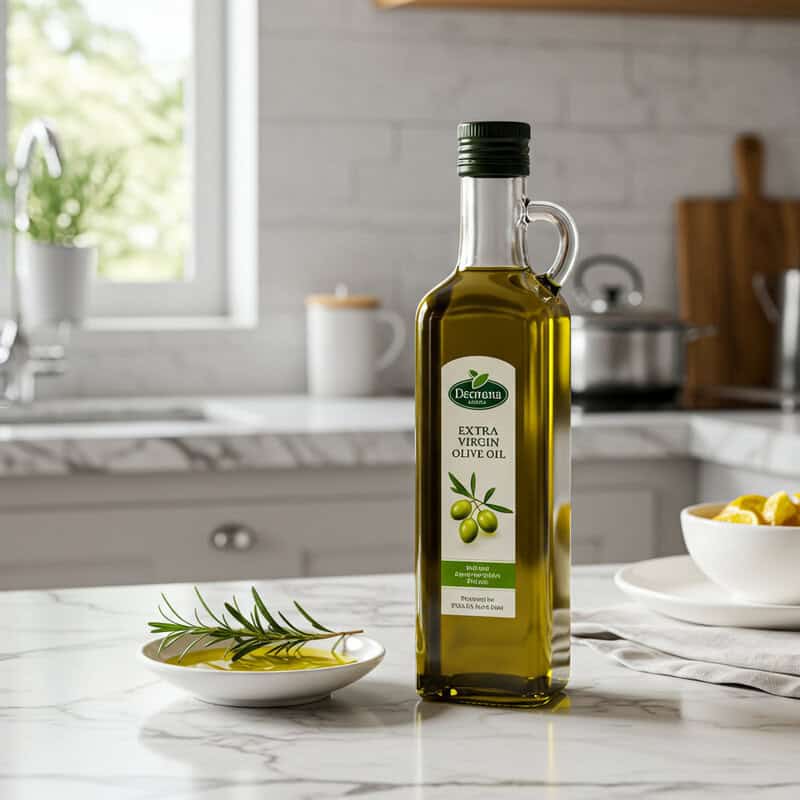
Extra virgin olive oil is a staple of the Mediterranean diet and is widely recognized for its anti-inflammatory benefits. The key compound responsible is oleocanthal, a natural phenolic compound that has been shown to work similarly to ibuprofen by inhibiting inflammatory enzymes in the body (source). Regular consumption of extra virgin olive oil has been linked to reduced levels of inflammatory markers and a lower risk of chronic diseases such as cardiovascular disease and arthritis.
When compared with other cooking oils, such as corn, soybean, or sunflower oil, extra virgin olive oil stands out for its robust antioxidant profile and lower omega-6 fatty acid content, which can contribute to inflammation when consumed in excess (source). This makes it a healthier choice for daily use, especially for those focused on reducing inflammation.
For best results, use extra virgin olive oil in salad dressings, drizzled over roasted vegetables, or as a finishing oil for soups and stews. While it can be used for sautéing, it is best to avoid high-heat frying to preserve its beneficial compounds. Choose cold-pressed, high-quality oils for maximum health benefits.
5. Spinach
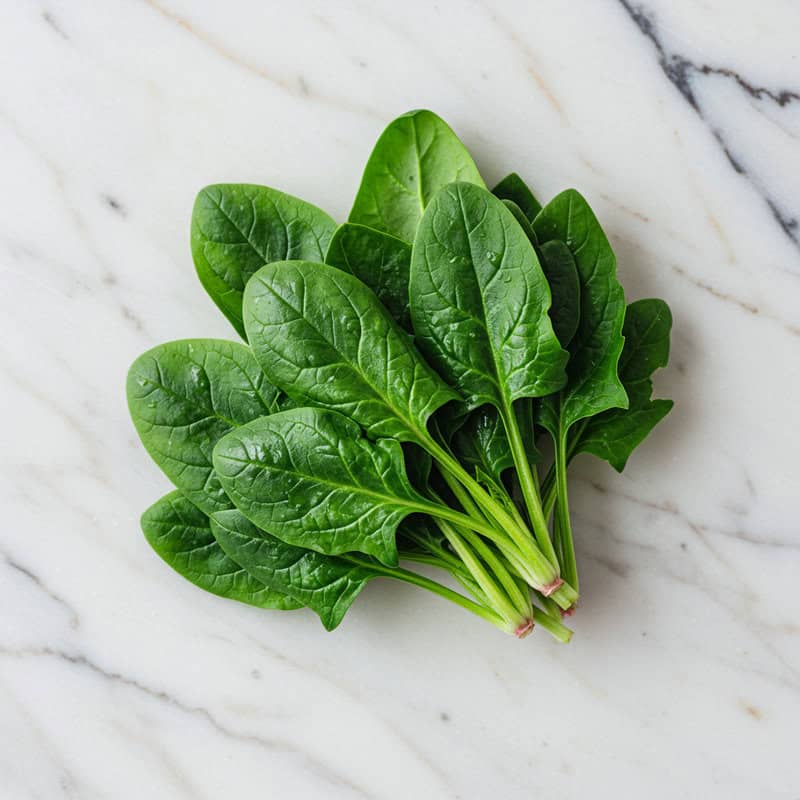
Spinach is a leafy green vegetable packed with antioxidants that help reduce inflammation, notably lutein and zeaxanthin. These carotenoids are well-known for their ability to protect cells from oxidative stress and support eye health, while also lowering inflammatory markers in the body (source). Spinach is also rich in vitamins A, C, and K, which further contribute to its anti-inflammatory profile.
When compared to kale, spinach offers higher levels of lutein and zeaxanthin, making it particularly effective for those seeking to boost their antioxidant intake. While kale boasts more vitamin C and fiber, spinach is often preferred for its milder flavor and versatility in recipes (source).
To retain spinach’s valuable nutrients, it’s best to consume it raw or lightly cooked. Overcooking can lead to the loss of water-soluble vitamins and antioxidants. Try adding fresh spinach to salads, sandwiches, or smoothies. If you prefer it cooked, opt for quick sautéing or steaming. Pairing spinach with a healthy fat, such as olive oil, can enhance the absorption of its fat-soluble nutrients.
6. Walnuts

Walnuts are a powerhouse of alpha-linolenic acid (ALA), a plant-based omega-3 fatty acid known for its anti-inflammatory properties. ALA helps modulate the immune response and reduce the production of inflammatory molecules in the body, making walnuts an excellent choice for those seeking to manage inflammation through diet (source). Regular walnut consumption has also been linked to improved heart health and lower risk of chronic diseases.
Compared to other nuts, walnuts stand out for their omega-3 content. While almonds, cashews, and pistachios provide healthy fats and protein, they lack significant amounts of ALA. This unique nutrient profile makes walnuts especially valuable for individuals who follow plant-based diets and may not consume fish or other direct sources of omega-3s (source).
For optimal anti-inflammatory benefits, a recommended serving is about one ounce, or roughly a small handful (approximately 14 walnut halves) per day. Enjoy walnuts as a snack, sprinkle them on salads or oatmeal, or blend them into smoothies. Store walnuts in the refrigerator to maintain freshness and preserve their healthy fats.
7. Ginger
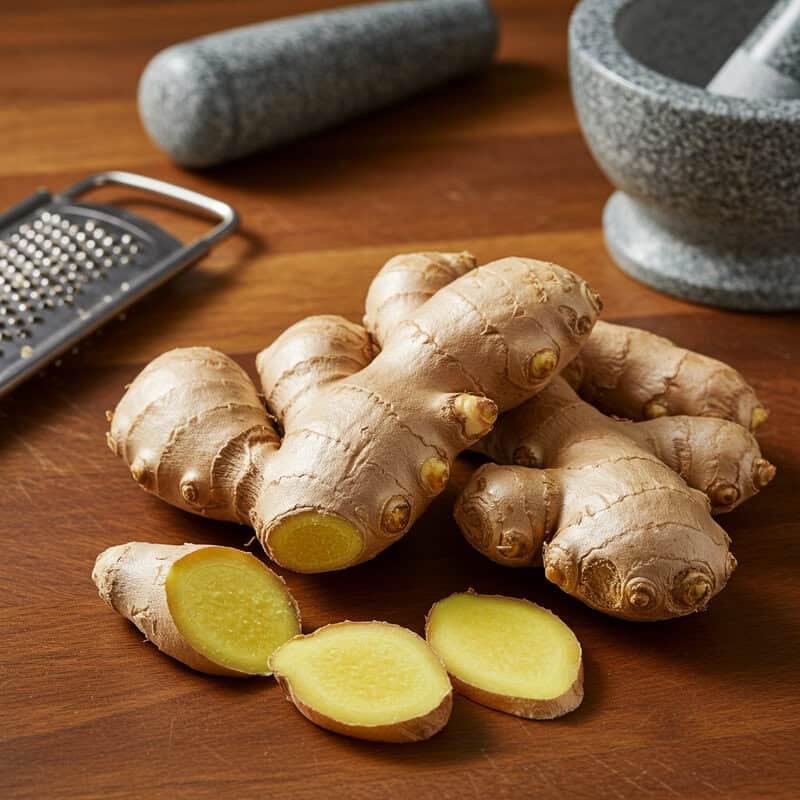
Ginger is celebrated for its potent anti-inflammatory compound called gingerol, which is responsible for the root’s distinctive spicy flavor and many of its medicinal benefits. Gingerol works by inhibiting the production of pro-inflammatory cytokines and enzymes, helping to alleviate pain and reduce chronic inflammation in the body (source). Studies have shown that ginger can be particularly effective for people suffering from osteoarthritis and other inflammatory conditions.
Historically, ginger has played a central role in traditional medicine systems, such as Ayurveda and traditional Chinese medicine. It has long been used to treat digestive issues, colds, nausea, and inflammatory ailments. Its warming, soothing properties have made it a staple in natural home remedies across many cultures (source).
Incorporating ginger into your daily diet is easy and flavorful. Try slicing fresh ginger and steeping it in hot water for a soothing anti-inflammatory tea. Grate or mince ginger and add it to stir-fries, soups, or marinades for a zesty kick. For a simple health boost, mix ginger with lemon and honey in warm water as a morning tonic.
8. Tomatoes
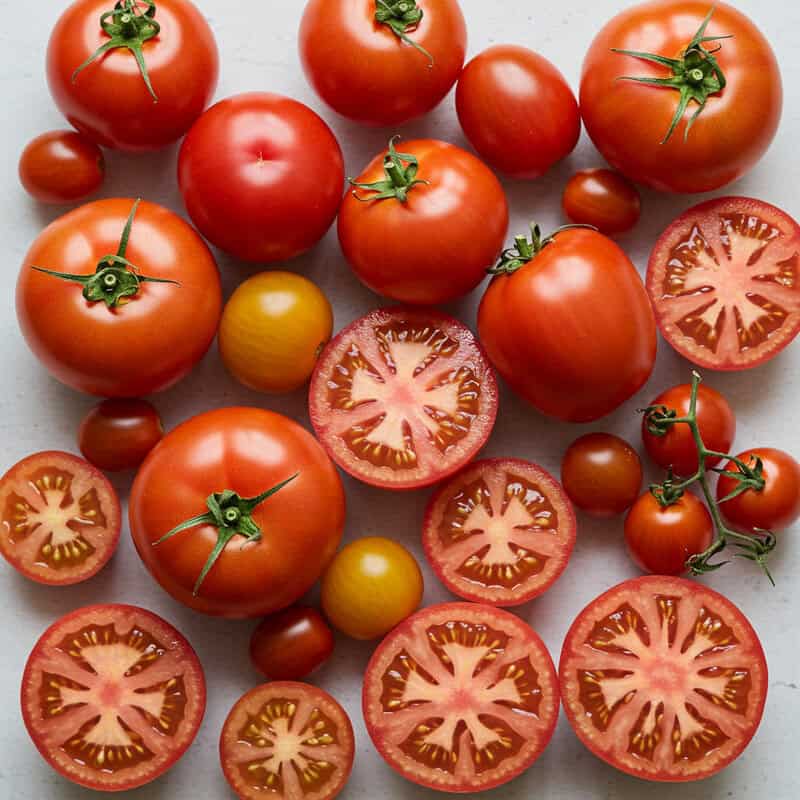
Tomatoes are a rich source of lycopene, a powerful antioxidant known for its ability to combat oxidative stress and reduce inflammation throughout the body. Lycopene works by neutralizing free radicals and has been linked to lower levels of inflammatory markers, particularly in conditions related to cardiovascular health (source). Regular consumption of tomatoes can contribute to a healthier immune response and protect against chronic diseases.
While both raw and cooked tomatoes provide health benefits, cooking tomatoes actually increases the bioavailability of lycopene. Heat breaks down cell walls, making lycopene more accessible for absorption in the digestive tract. For example, tomato sauces, soups, and stews generally deliver more absorbable lycopene than raw slices (source).
To further boost lycopene absorption, pair tomatoes with a healthy fat such as olive oil. Try recipes like homemade tomato sauce, roasted tomatoes drizzled with extra virgin olive oil, or a classic Caprese salad with fresh mozzarella and basil. These combinations not only enhance flavor but also maximize the anti-inflammatory benefits of this versatile fruit.
9. Broccoli
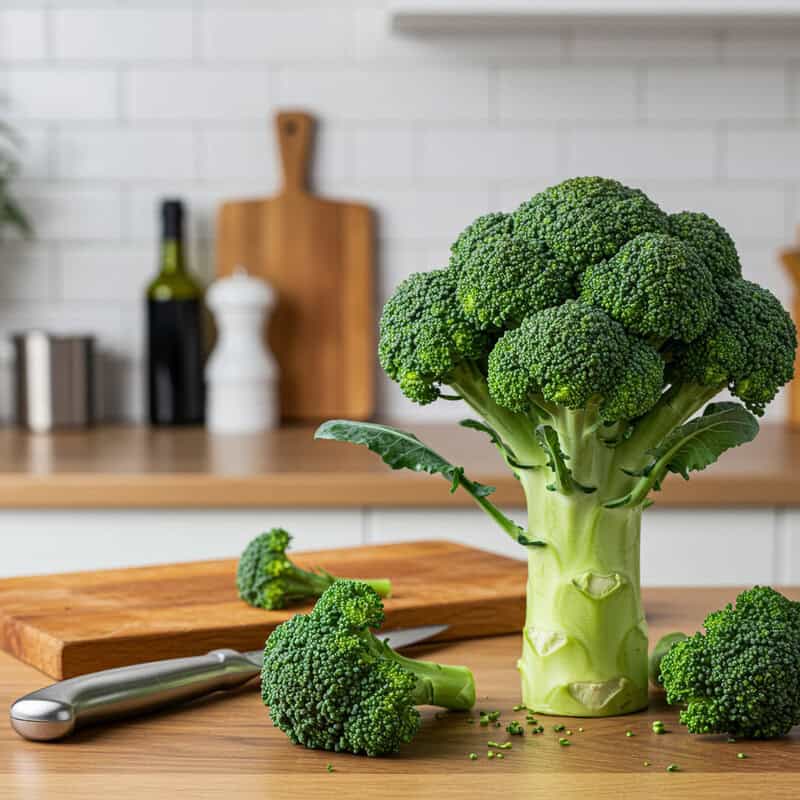
Broccoli stands out among vegetables for its high concentration of sulforaphane, a sulfur-rich compound known for its strong anti-inflammatory and antioxidant effects. Sulforaphane activates enzymes that protect cells from oxidative damage and helps suppress the processes that lead to chronic inflammation (source). Additionally, broccoli is an excellent source of vitamin C, which further supports immune function and reduces inflammation by neutralizing free radicals in the body.
Compared to other cruciferous vegetables such as cauliflower, Brussels sprouts, and cabbage, broccoli offers one of the highest levels of sulforaphane. While all cruciferous vegetables contribute valuable nutrients and anti-inflammatory benefits, broccoli’s unique combination of sulforaphane and vitamin C makes it an especially potent choice for inflammation prevention (source).
To maximize sulforaphane content, lightly steam broccoli rather than boiling or microwaving it, as prolonged heat can degrade its beneficial compounds. Chopping broccoli and letting it rest for a few minutes before cooking can also help activate sulforaphane. Add steamed broccoli to salads, grain bowls, or stir-fries, or enjoy it as a simple side dish topped with a drizzle of olive oil and lemon juice.
10. Avocado
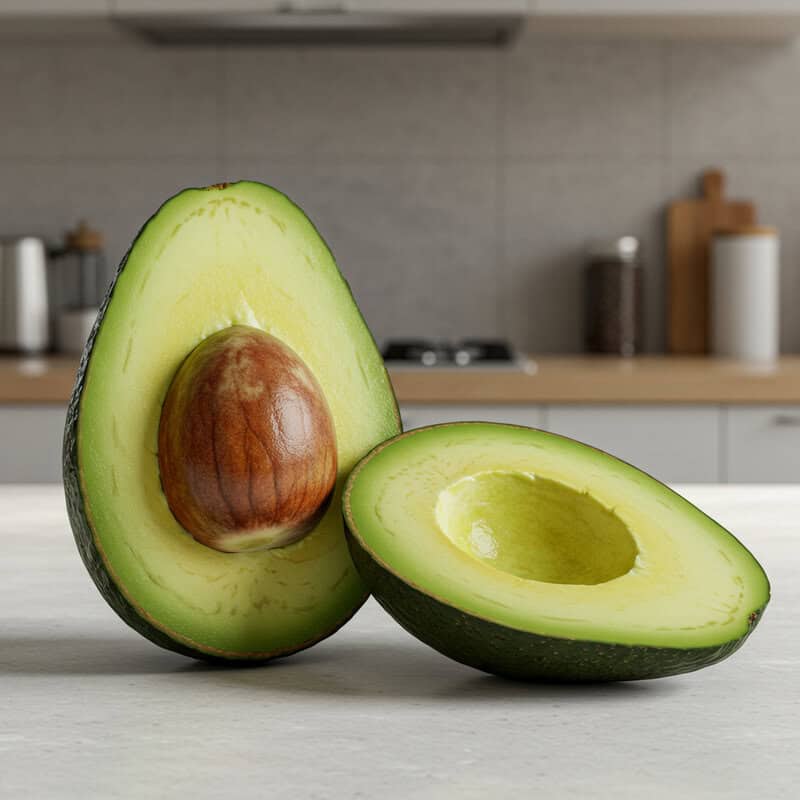
Avocado is a nutrient-dense fruit packed with heart-healthy monounsaturated fats, which play a significant role in reducing inflammation in the body. Monounsaturated fats help lower levels of inflammatory markers and support overall cardiovascular health. In addition to these beneficial fats, avocados contain phytosterols—plant compounds that further modulate the body’s inflammatory response and support immune balance (source).
When compared to butter, avocado stands out as a much healthier fat source. Butter is high in saturated fats, which have been linked to increased inflammation and higher risk of chronic disease when consumed in excess. Replacing butter with avocado can help lower cholesterol levels and support a healthier inflammatory profile (source).
Avocado’s creamy texture and mild flavor make it a versatile addition to many dishes. Spread mashed avocado on whole-grain toast, blend it into smoothies for a rich consistency, or dice it into salads, grain bowls, and tacos. It’s also a perfect topping for soups and can be used to make homemade guacamole. Pairing avocado with tomatoes, citrus, or leafy greens maximizes both flavor and nutrition.
11. Chia Seeds
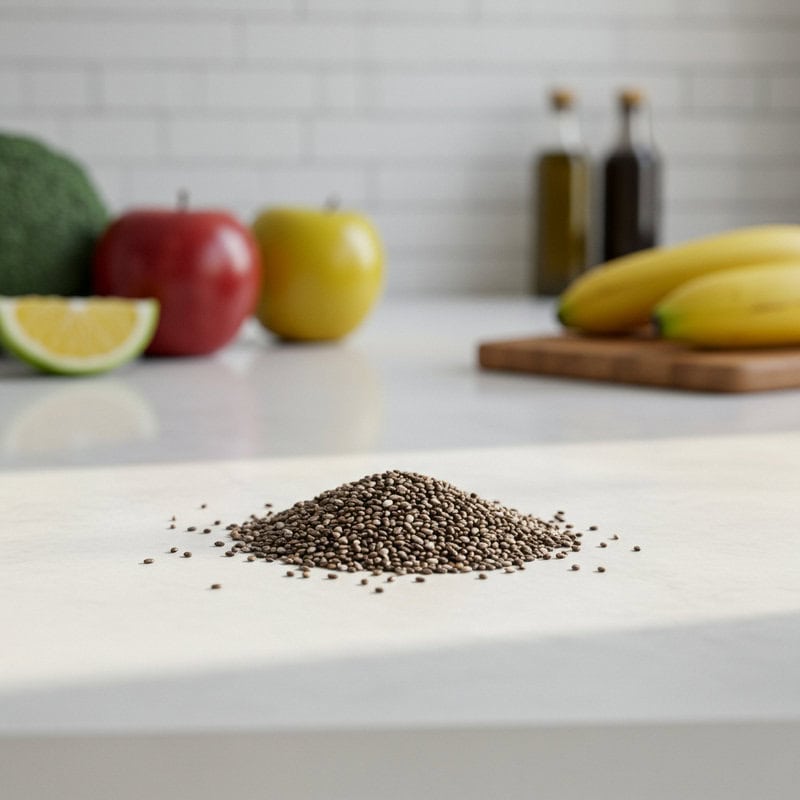
Chia seeds are tiny powerhouses of nutrition, renowned for their high omega-3 fatty acid and fiber content. The primary omega-3 in chia seeds is alpha-linolenic acid (ALA), a plant-based fatty acid with proven anti-inflammatory effects. Consuming ALA helps reduce the production of inflammatory compounds and supports cardiovascular and metabolic health (source). In addition, chia seeds are an excellent source of soluble fiber, which promotes gut health and further lowers inflammation by supporting a healthy gut microbiome.
When compared to flaxseeds, chia seeds offer a similar omega-3 profile but have a slight edge in convenience. Unlike flaxseeds, which need to be ground for optimal nutrient absorption, chia seeds can be eaten whole and still provide their full nutritional benefits (source). Both seeds are excellent choices, but chia’s versatility in recipes makes it particularly easy to use.
To enjoy chia seeds at breakfast, stir them into oatmeal, yogurt, or smoothies. You can also make chia pudding by soaking the seeds in milk or a non-dairy alternative overnight. Sprinkle chia seeds over cereal or blend them into pancake batter for a subtle crunch and a nutritious boost.
12. Garlic
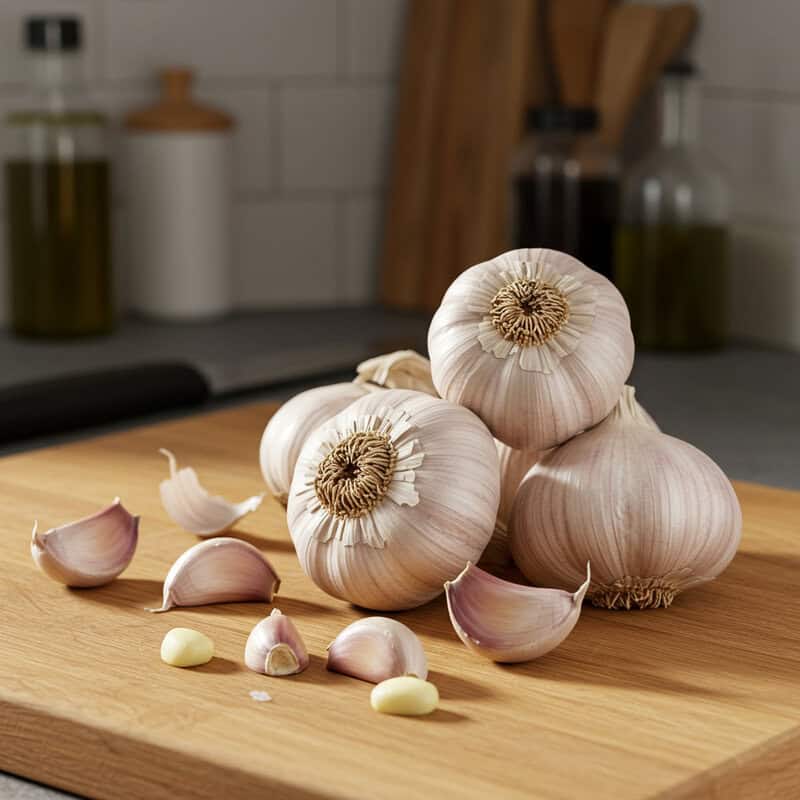
Garlic is celebrated for its potent anti-inflammatory and immune-boosting properties, largely attributed to the compound allicin. Allicin is formed when garlic is crushed or chopped, and it works by inhibiting pro-inflammatory enzymes and reducing oxidative stress in the body (source). Regular garlic consumption has been linked to lowered risk of inflammatory diseases, improved cardiovascular health, and enhanced immune function.
Throughout history, garlic has been used in traditional medicine for its healing abilities. Ancient Egyptians, Greeks, Romans, and Chinese civilizations valued garlic as a remedy for infections, digestive issues, and respiratory conditions. Its reputation as a natural antibiotic and anti-inflammatory agent persists in folk medicine across the world (source).
To maximize allicin formation, crush or chop garlic cloves and let them rest for about 10 minutes before cooking or adding to dishes. This resting period allows the enzyme alliinase to convert alliin into allicin. Add raw garlic to dressings, dips, or salsas, or stir it into dishes near the end of cooking to preserve its beneficial compounds and robust flavor.
13. Red Grapes

Red grapes are a rich source of resveratrol, a powerful polyphenol with well-documented anti-inflammatory and antioxidant properties. Resveratrol helps reduce inflammation by inhibiting the activity of inflammatory enzymes and signaling pathways, supporting cardiovascular health and potentially reducing the risk of chronic diseases (source). The skin of red grapes contains the highest concentration of resveratrol, making whole, fresh grapes especially beneficial.
Many people associate resveratrol with red wine, as the fermentation process concentrates this compound. However, fresh red grapes offer similar anti-inflammatory benefits without the risks associated with alcohol consumption. While moderate red wine intake has been linked to some health benefits, eating red grapes delivers the same polyphenols along with fiber, vitamins, and hydration—without added calories from alcohol (source).
For easy, anti-inflammatory snacking, enjoy red grapes on their own, add them to fruit salads, or pair them with nuts and seeds for a balanced snack. You can also freeze grapes for a refreshing treat or toss them into green salads for a burst of natural sweetness and nutrition. Choose organic grapes when possible to avoid pesticide residues.
14. Sweet Potatoes

Sweet potatoes are a nutritional powerhouse, particularly valued for their high beta-carotene content. Beta-carotene is a potent antioxidant that the body converts into vitamin A, supporting immune function and reducing inflammation by neutralizing cell-damaging free radicals (source). Consuming sweet potatoes regularly can help lower inflammatory markers and promote overall health, especially for the skin, eyes, and immune system.
Compared to regular white potatoes, sweet potatoes offer several anti-inflammatory advantages. They contain higher levels of antioxidants, vitamins, and fiber, while having a lower glycemic index, which means they cause a slower and steadier rise in blood sugar levels. This quality makes sweet potatoes a better choice for those seeking to manage inflammation and blood sugar together (source).
For the best flavor and nutrient retention, try roasting sweet potatoes. Cut them into wedges or cubes, toss with olive oil, and season with spices like turmeric, black pepper, or paprika. Roast at 400°F (200°C) until golden and tender. Roasting enhances their natural sweetness and preserves beta-carotene, making them a delicious, anti-inflammatory side dish.
15. Green Tea

Green tea is renowned for its high concentration of epigallocatechin gallate (EGCG), a potent antioxidant that exerts powerful anti-inflammatory effects. EGCG works by neutralizing free radicals, reducing oxidative stress, and modulating inflammatory pathways, which can help lower the risk of chronic diseases such as heart disease and certain cancers (source). Regular consumption of green tea has been associated with improved immune health and reduced inflammation throughout the body.
When compared to black tea, green tea typically contains higher levels of EGCG and other catechins, as it undergoes minimal oxidation during processing. Black tea, while still beneficial, has a different profile of antioxidants due to fermentation, making green tea the superior choice for those specifically seeking anti-inflammatory properties (source).
To maximize the benefits of green tea, brew it at a temperature of 160-185°F (70-85°C) for 2-3 minutes. Avoid boiling water, as excessive heat can degrade EGCG and diminish the tea’s beneficial effects. Enjoy green tea plain or with a slice of lemon for added flavor and antioxidant support, making it a soothing daily ritual.
16. Almonds
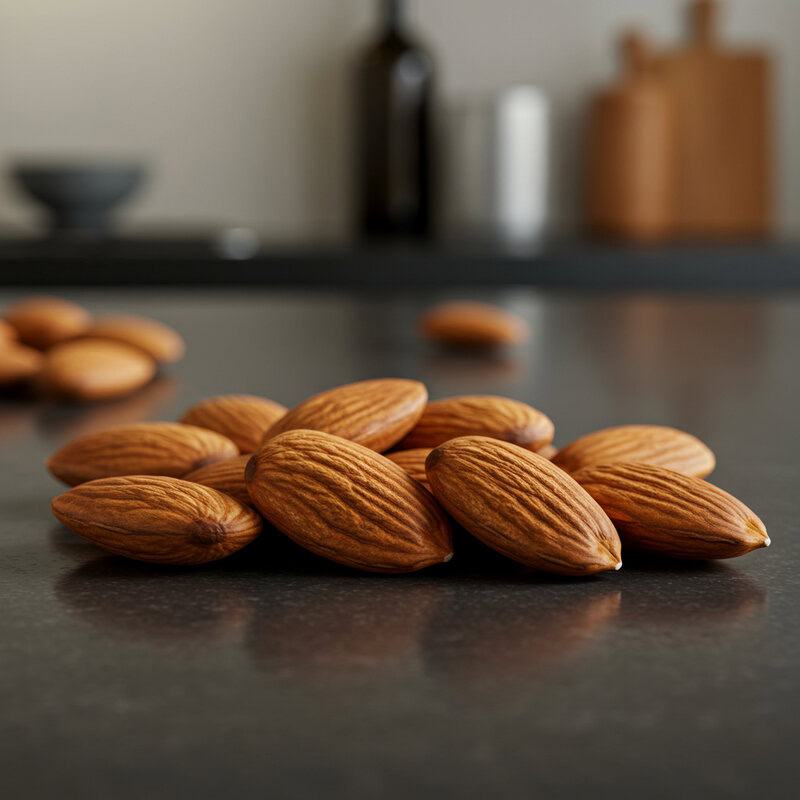
Almonds are a nutrient-dense nut, celebrated for their high vitamin E and polyphenol content—two factors that contribute significantly to their anti-inflammatory potential. Vitamin E is a powerful antioxidant that helps protect cells from oxidative damage, while almond polyphenols have been shown to modulate inflammatory pathways and support cardiovascular health (source). Regular intake of almonds has been associated with reduced levels of C-reactive protein (CRP), a marker of inflammation in the body.
Compared to peanuts, almonds generally provide more vitamin E and a broader range of polyphenols. While peanuts also contain beneficial nutrients, they are actually legumes rather than true nuts and have a slightly different fat composition. Almonds, with their high monounsaturated fat content, are considered more effective for reducing inflammation and supporting heart health (source).
To gain the anti-inflammatory benefits of almonds without excess calories, portion control is key. A serving size of about 1 ounce (23 almonds) per day is ideal. Enjoy almonds as a snack, add them to salads or oatmeal, or use almond butter in smoothies and spreads. Choose unsalted, raw, or dry-roasted varieties for the healthiest option.
17. Berries (General)

Berries are among the most potent anti-inflammatory foods, thanks to their diverse and abundant polyphenol content. Polyphenols are plant compounds that act as antioxidants and modulate inflammatory pathways, contributing to reduced oxidative stress and improved immune function. Strawberries, raspberries, and blackberries each offer unique strengths in the fight against inflammation (source).
Strawberries are particularly rich in ellagic acid and anthocyanins, both of which have been shown to lower inflammatory markers and reduce risk factors for heart disease. Raspberries are notable for their high levels of ellagitannins, which possess strong antioxidant and anti-inflammatory effects, and may also help regulate blood sugar. Blackberries provide an impressive concentration of anthocyanins—the pigments responsible for their deep color—which have demonstrated the ability to reduce oxidative damage and inflammatory processes in the body (source).
Including a variety of berries in your diet maximizes your intake of these protective compounds. Enjoy them fresh, frozen, or blended into smoothies, yogurt, or oatmeal. Rotating different types of berries ensures a broad spectrum of polyphenols and amplifies their collective anti-inflammatory benefits.
18. Dark Chocolate

Dark chocolate is not only a delicious treat but also a valuable source of flavanols, a group of potent antioxidants known for their anti-inflammatory properties. Flavanols help reduce oxidative stress, lower blood pressure, and support vascular health by improving endothelial function (source). To reap these benefits, it’s important to choose dark chocolate with a minimum cacao content of 70% or higher, as higher cacao levels are associated with greater flavanol concentrations.
When compared to milk chocolate, dark chocolate contains significantly more flavanols and less added sugar and dairy. Milk chocolate is often diluted with milk solids and sweeteners, which not only lowers its antioxidant content but also adds excess calories and sugar that may contribute to inflammation (source). For those seeking anti-inflammatory effects, dark chocolate is the superior choice.
Moderation is key when incorporating dark chocolate into your diet. A small serving of about 1 ounce (28 grams) a few times a week is enough to enjoy its health benefits without consuming too many calories or added sugars. Enjoy dark chocolate on its own, melted over fruit, or chopped into oatmeal for a satisfying, healthy indulgence.
19. Beets
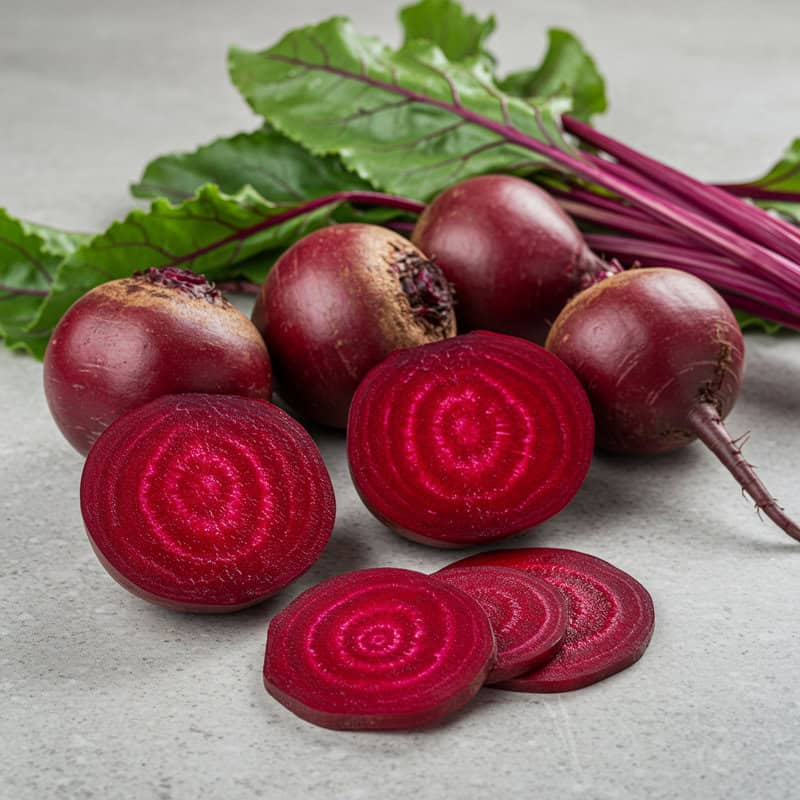
Beets are celebrated for their vivid color and unique anti-inflammatory compounds, particularly betalains and dietary nitrates. Betalains are powerful antioxidants that help combat oxidative stress and suppress inflammation at the cellular level. In addition, dietary nitrates found in beets are converted by the body into nitric oxide, a molecule that relaxes blood vessels, improves circulation, and further reduces inflammation (source). These properties make beets a standout vegetable for supporting cardiovascular and overall health.
When compared to carrots, beets offer a different antioxidant profile. While carrots are rich in beta-carotene, which supports immune function and eye health, they lack betalains and have lower nitrate content. Both root vegetables provide valuable nutrients and fiber, but beets may offer superior anti-inflammatory effects due to their unique compounds (source).
To enjoy beets at their best, try roasting them. Scrub and peel the beets, then cut into wedges or cubes. Toss with olive oil, salt, and pepper, and roast at 400°F (200°C) for 30-40 minutes until tender. Roasting enhances their natural sweetness and preserves betalain content, making them a delicious addition to salads and grain bowls.
20. Mushrooms

Mushrooms are a unique source of anti-inflammatory nutrients, particularly ergothioneine and selenium. Ergothioneine is a powerful antioxidant amino acid that helps protect cells from oxidative stress and reduces inflammation in the body (source). Selenium, a trace mineral found abundantly in mushrooms, also plays a crucial role in supporting immune function and lowering inflammation by participating in antioxidant enzyme systems.
Different mushroom varieties offer varying benefits. Shiitake mushrooms are especially rich in polysaccharides and beta-glucans, which help modulate immune response and have been linked to lower inflammation levels. Portobello mushrooms, on the other hand, are a good source of selenium and B vitamins. White button mushrooms, although milder in flavor, still provide valuable antioxidants and nutrients (source).
For best results, cook mushrooms lightly to preserve their nutrients. Sautéing with a small amount of olive oil or grilling are excellent options. Avoid overcooking, as prolonged heat can degrade sensitive compounds like ergothioneine. Add mushrooms to stir-fries, omelets, soups, or salads for a flavorful, anti-inflammatory boost to your meals.
21. Oranges

Oranges are renowned for their high vitamin C content, a vital nutrient that supports immune function and helps combat inflammation. Vitamin C acts as a potent antioxidant, neutralizing free radicals and reducing oxidative stress, which in turn helps lower inflammatory markers in the body (source). Regular consumption of oranges and other vitamin C-rich foods has been linked to improved immune defense and a decreased risk of chronic inflammatory diseases.
When compared to other citrus fruits like grapefruits, lemons, and limes, oranges offer one of the highest levels of vitamin C per serving. While all citrus varieties provide beneficial antioxidants and flavonoids, oranges stand out for their superior vitamin C content and natural sweetness, making them a popular and accessible choice (source).
To enjoy the anti-inflammatory benefits of oranges, eat them fresh as a snack, add orange segments to salads, or use the zest and juice to brighten up dressings and marinades. Pairing oranges with nuts, leafy greens, or other fruits creates flavorful combinations that amplify both the taste and nutritional value of your meals.
22. Flaxseeds
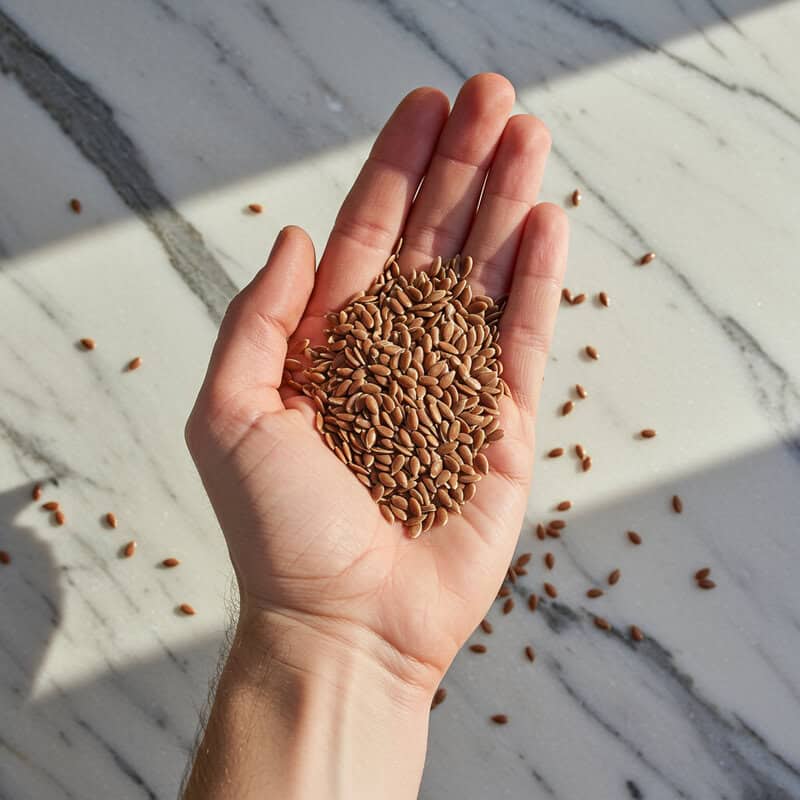
Flaxseeds are highly valued for their dual anti-inflammatory benefits: they are rich in both lignans and omega-3 fatty acids. Lignans are unique plant compounds that function as antioxidants and phytoestrogens, helping to reduce oxidative stress and modulate inflammation, especially in cardiovascular and hormonal health (source). Additionally, flaxseeds are one of the best plant sources of alpha-linolenic acid (ALA), an omega-3 fatty acid that further helps decrease inflammatory processes in the body.
While chia seeds also provide ALA omega-3s, flaxseeds contain much higher amounts of lignans, giving them an edge in supporting hormone balance and offering antioxidant protection. Both seeds deliver beneficial fiber and healthy fats, but flaxseeds are particularly prized for their lignan content (source).
For optimal nutrient absorption, it’s best to consume flaxseeds ground rather than whole, as the hard outer shell of the whole seed can pass through the digestive tract undigested. Add ground flaxseed to smoothies, oatmeal, or yogurt, or mix into baked goods. Store flaxseed in the refrigerator to preserve freshness and prevent oxidation of the oils.
23. Red Bell Peppers

Red bell peppers are a vibrant and flavorful source of powerful antioxidants, most notably vitamin C and beta-carotene. Vitamin C is essential for immune function and helps protect cells from oxidative stress, while beta-carotene—a precursor to vitamin A—supports vision, skin health, and further reduces inflammation in the body (source). Consuming foods rich in these nutrients can help lower inflammatory markers and promote overall wellness.
When compared to green bell peppers, red bell peppers contain significantly higher levels of both vitamin C and beta-carotene. This is because red peppers are fully ripened versions of green peppers, allowing more time for these antioxidants to develop. Green peppers are still nutritious, but red bell peppers offer a superior anti-inflammatory and nutrient profile (source).
Red bell peppers are delicious both raw and cooked. Eating them raw in salads, salsas, or as crudités maximizes their vitamin C content, as this nutrient is sensitive to heat. For a sweeter flavor and softer texture, try roasting, grilling, or sautéing red peppers and adding them to pasta dishes, stir-fries, or sandwiches.
24. Apples

Apples are an accessible and widely enjoyed fruit, celebrated for their anti-inflammatory benefits largely attributed to quercetin. Quercetin is a potent flavonoid antioxidant that helps neutralize free radicals, modulate immune responses, and reduce the production of pro-inflammatory cytokines (source). Regular apple consumption is linked to reduced inflammation, improved cardiovascular health, and lower risk of chronic diseases.
Different apple varieties offer varying levels of antioxidants, including quercetin. Red apples such as Red Delicious and Fuji tend to have higher quercetin and polyphenol concentrations compared to lighter-skinned varieties like Golden Delicious. Tart apples, such as Granny Smith, often contain more vitamin C, which further aids in reducing inflammation (source).
To maximize the anti-inflammatory effects, it is best to eat apples with their skin on, as most of the quercetin and fiber are concentrated in the peel. Wash apples thoroughly to remove any pesticide residues, or choose organic when possible. Enjoy apples as a portable snack, slice them into salads, or pair them with nut butter for a nutrient-rich, anti-inflammatory treat.
25. Pumpkin Seeds

Pumpkin seeds, also known as pepitas, are a concentrated source of important minerals like magnesium and zinc, both of which play crucial roles in combating inflammation. Magnesium helps regulate inflammatory responses and supports muscle and nerve function, while zinc contributes to immune health and modulates the body’s inflammatory pathways (source). Regular inclusion of pumpkin seeds in the diet has been associated with reduced inflammation, improved metabolic health, and better immune function.
Compared to sunflower seeds, pumpkin seeds generally offer higher levels of magnesium and zinc, though sunflower seeds are a great source of vitamin E and healthy fats. Both seeds are nutritious, but pumpkin seeds are particularly valuable for those seeking to boost their mineral intake and manage inflammation (source).
To enjoy pumpkin seeds, try toasting them for extra flavor and crunch. Simply spread raw seeds on a baking sheet, toss with a little olive oil and your favorite spices, and bake at 300°F (150°C) for about 10-15 minutes, stirring occasionally. Toasted pumpkin seeds make a versatile topping for salads, soups, yogurt, or whole grain dishes.
26. Oats
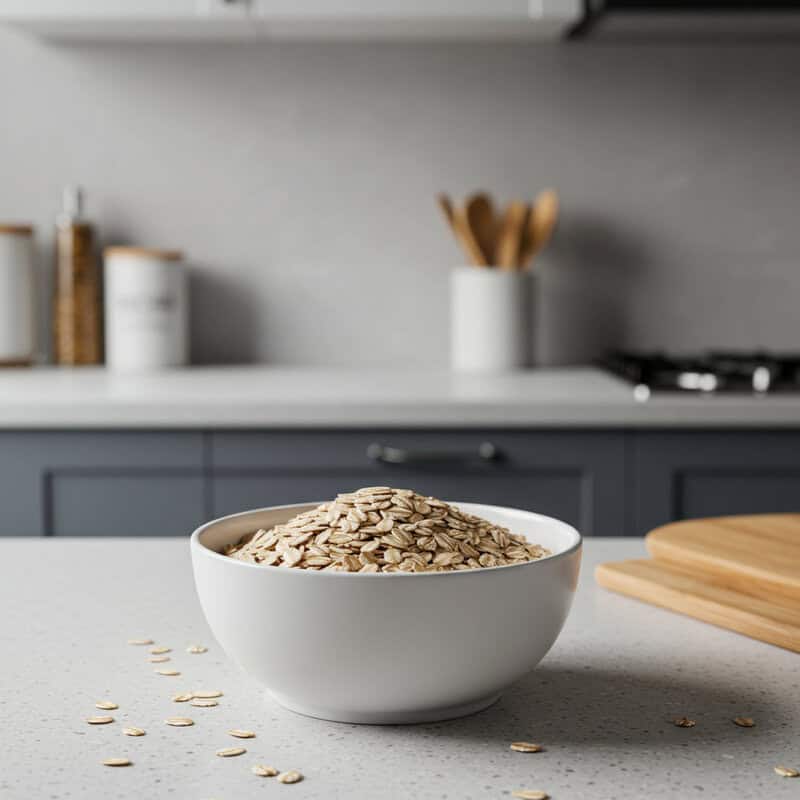
Oats are a whole grain celebrated for their high content of beta-glucan fiber, a unique soluble fiber that has been extensively studied for its anti-inflammatory and heart health benefits. Beta-glucans help lower cholesterol, stabilize blood sugar, and support a healthy gut microbiome, which in turn reduces low-grade inflammation throughout the body (source). Consuming oats regularly can have a positive effect on immune function and metabolic health.
When compared to other grains such as wheat, rice, and barley, oats contain the highest levels of beta-glucan. While barley is also a good source, oats are more readily available and versatile, making them a convenient choice for daily meals. Other grains may offer fiber, but the specific benefits of beta-glucan are unique to oats and barley (source).
For a simple and nutritious breakfast, try making overnight oats. Combine rolled oats with milk or a non-dairy alternative, chia seeds, and your favorite fruits and nuts in a jar. Let the mixture soak in the refrigerator overnight. In the morning, you’ll have a ready-to-eat, anti-inflammatory meal packed with fiber and nutrients.
27. Black Beans
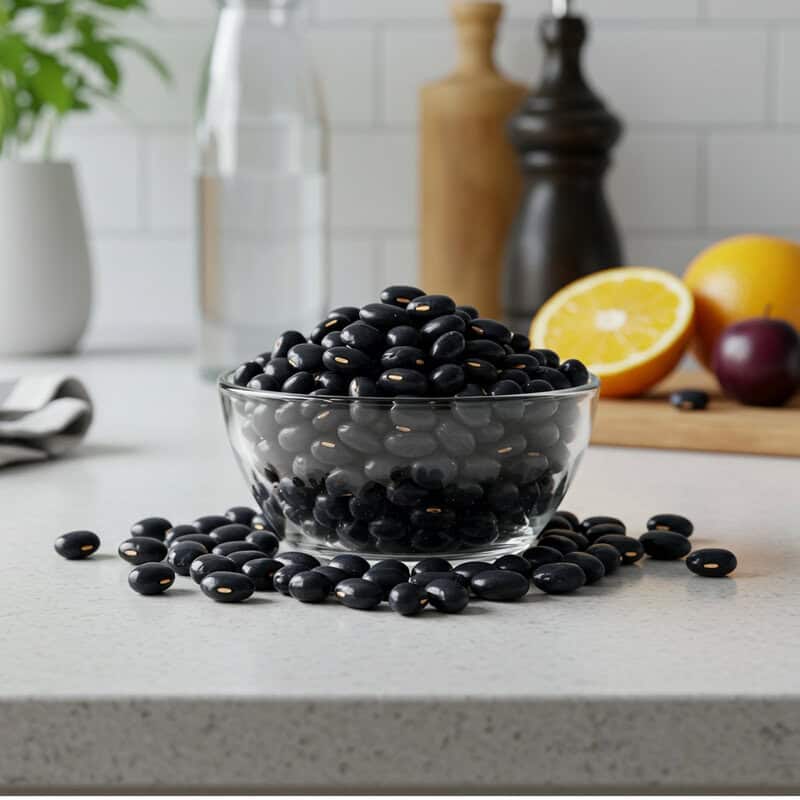
Black beans are a powerhouse legume, rich in polyphenols and dietary fiber—two key nutrients with potent anti-inflammatory effects. The dark color of black beans comes from anthocyanins, a group of polyphenols that act as antioxidants, reducing oxidative stress and helping to lower inflammation throughout the body (source). Additionally, the high soluble fiber content of black beans supports gut health, helps regulate blood sugar, and further reduces inflammation by promoting a healthy microbiome.
Compared to kidney beans, black beans generally contain higher concentrations of anthocyanins and have a slightly higher fiber content. Both types of beans are excellent sources of plant-based protein and minerals, but black beans offer a unique blend of antioxidants that provide added anti-inflammatory benefits (source).
To maximize nutrition and digestibility, soak dried black beans overnight before cooking. Drain and rinse them, then simmer in fresh water until tender. This process reduces cooking time and helps decrease compounds that may cause digestive discomfort. Add cooked black beans to salads, soups, tacos, or grain bowls for a filling, anti-inflammatory boost to your meals.
28. Kale
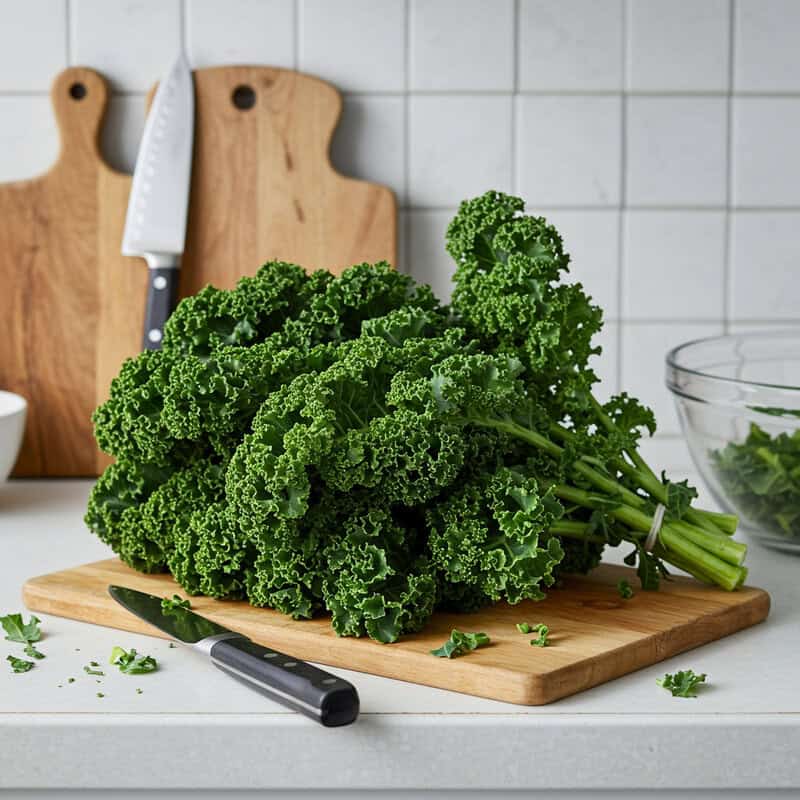
Kale is a nutrient-dense leafy green renowned for its high levels of antioxidants and vitamin K, both of which play a significant role in reducing inflammation. The antioxidants in kale—including quercetin, kaempferol, and beta-carotene—help neutralize free radicals and lower oxidative stress, which are key factors in chronic inflammation (source). Vitamin K, abundant in kale, supports bone health and has been shown to help regulate inflammatory processes in the body.
When compared to spinach, kale provides more vitamin K and a broader spectrum of antioxidants, while spinach contains higher levels of lutein and zeaxanthin, which are beneficial for eye health. Both greens are low in calories and packed with vitamins and minerals, but kale’s robust antioxidant profile gives it a unique anti-inflammatory edge (source).
Kale can be enjoyed raw in salads or blended into smoothies for a nutrient boost. To make kale salads more palatable, massage the leaves with a bit of olive oil and lemon juice to soften their texture. Add chopped kale to smoothies, soups, or grain bowls to increase your intake of anti-inflammatory compounds throughout the week.
29. Sardines

Sardines are a small, oily fish celebrated for their high content of omega-3 fatty acids, specifically EPA (eicosapentaenoic acid) and DHA (docosahexaenoic acid). These long-chain omega-3s are among the most effective dietary nutrients for reducing inflammation, supporting heart and brain health, and lowering the risk of chronic diseases (source). EPA and DHA work by modulating inflammatory pathways and reducing the production of inflammatory compounds in the body.
When compared to mackerel, sardines contain similar levels of omega-3s but have the added benefit of being lower on the food chain, which generally means they accumulate fewer heavy metals and toxins. Both sardines and mackerel are excellent sources of anti-inflammatory nutrients, but sardines are often praised for their sustainability and lower risk of contamination (source).
Sardines are widely available canned or fresh. Canned sardines are convenient, affordable, and retain most of their nutritional value, making them a practical choice for busy lifestyles. Fresh sardines offer a milder flavor and can be grilled or baked. Serve sardines on whole-grain toast, in salads, or tossed with pasta for a quick, anti-inflammatory meal.
30. Pomegranate

Pomegranate is a nutrient-dense fruit prized for its high content of punicalagins—potent polyphenols with strong antioxidant and anti-inflammatory effects. Punicalagins help reduce oxidative stress and inhibit inflammatory pathways, making pomegranate juice and seeds an excellent addition to an anti-inflammatory diet (source). Pomegranates are also rich in vitamin C, which supports immune function and further reduces inflammation by scavenging free radicals.
Compared to berry juices such as blueberry or cranberry, pomegranate juice generally offers higher levels of certain polyphenols, especially punicalagins, giving it a unique anti-inflammatory profile. While all berry and pomegranate juices provide antioxidants, pomegranate is particularly effective at reducing markers of inflammation and oxidative stress (source).
To enjoy fresh pomegranate seeds, score the fruit and break it open in a bowl of water. The seeds, or arils, will sink while the white membrane floats, making them easy to separate. Sprinkle pomegranate seeds over salads, yogurt, or oatmeal, or simply eat them as a tart-sweet snack to boost your daily intake of anti-inflammatory nutrients.
31. Brussels Sprouts
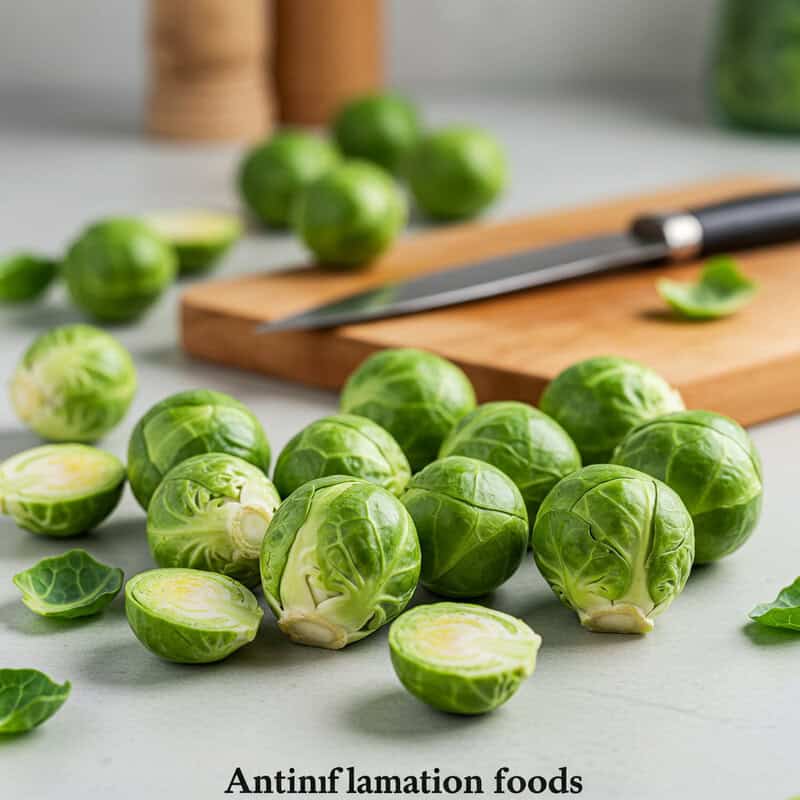
Brussels sprouts are a member of the cruciferous vegetable family and provide a significant dose of glucosinolates, which are sulfur-containing compounds known for their anti-inflammatory and cancer-preventive properties. When digested, glucosinolates are broken down into biologically active compounds such as sulforaphane, which help modulate inflammatory pathways and protect cells from oxidative damage (source). Brussels sprouts are also rich in vitamin C, further enhancing their ability to fight inflammation and support immune health.
Compared to broccoli, Brussels sprouts offer a similar profile of glucosinolates and vitamin C, although broccoli contains slightly higher levels of sulforaphane. Both vegetables are excellent additions to an anti-inflammatory diet, and including a variety of cruciferous vegetables ensures a diverse array of beneficial compounds (source).
Roasting is one of the best ways to prepare Brussels sprouts, as it brings out their natural sweetness and preserves nutrients. Toss halved Brussels sprouts with olive oil, salt, and pepper, then roast at 400°F (200°C) for 20-30 minutes until golden and crispy on the edges. Add lemon zest or balsamic vinegar after roasting for extra flavor and nutrition.
32. Coconut Oil
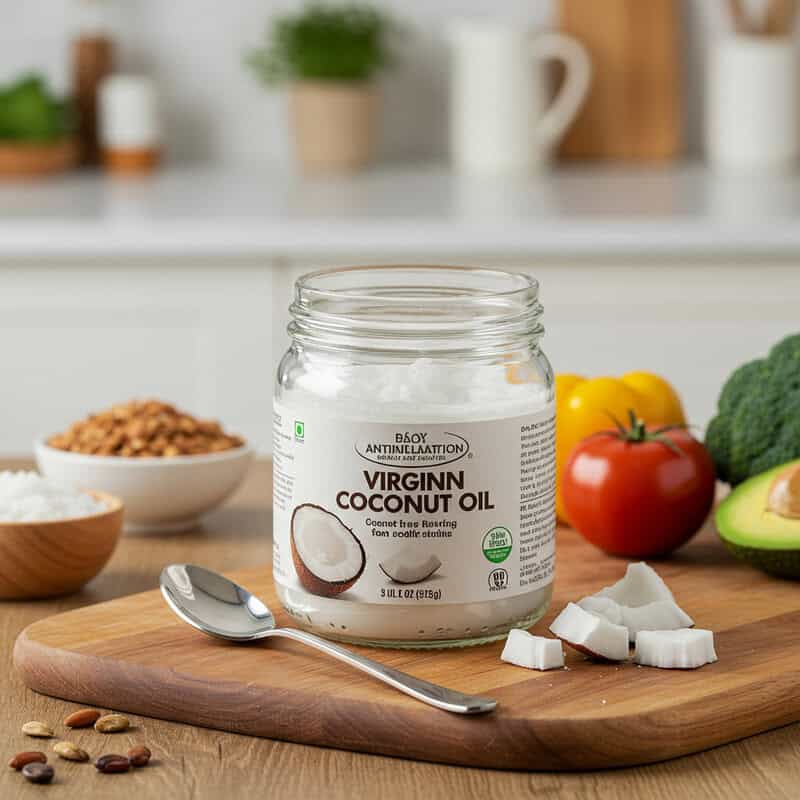
Coconut oil is unique among cooking oils for its high content of medium-chain triglycerides (MCTs), particularly lauric acid. MCTs are metabolized differently than long-chain fats, providing a quick source of energy and potentially supporting metabolic health (source). Some research suggests that MCTs may help reduce inflammation and oxidative stress, though the anti-inflammatory effects of coconut oil remain a topic of debate in the scientific community.
When compared to extra virgin olive oil, which is well-known for its anti-inflammatory properties due to oleocanthal and high antioxidant content, coconut oil has a different fatty acid profile and fewer proven heart-protective effects. Olive oil is generally considered the superior choice for reducing inflammation, especially in the context of a Mediterranean-style diet (source).
Coconut oil’s high smoke point makes it suitable for medium-heat cooking such as sautéing, baking, or adding to smoothies for a creamy texture. Its subtle coconut flavor pairs well with curries, roasted vegetables, and baked goods. For a balanced approach, consider using coconut oil occasionally while relying primarily on olive oil for daily anti-inflammatory cooking needs.
33. Carrots
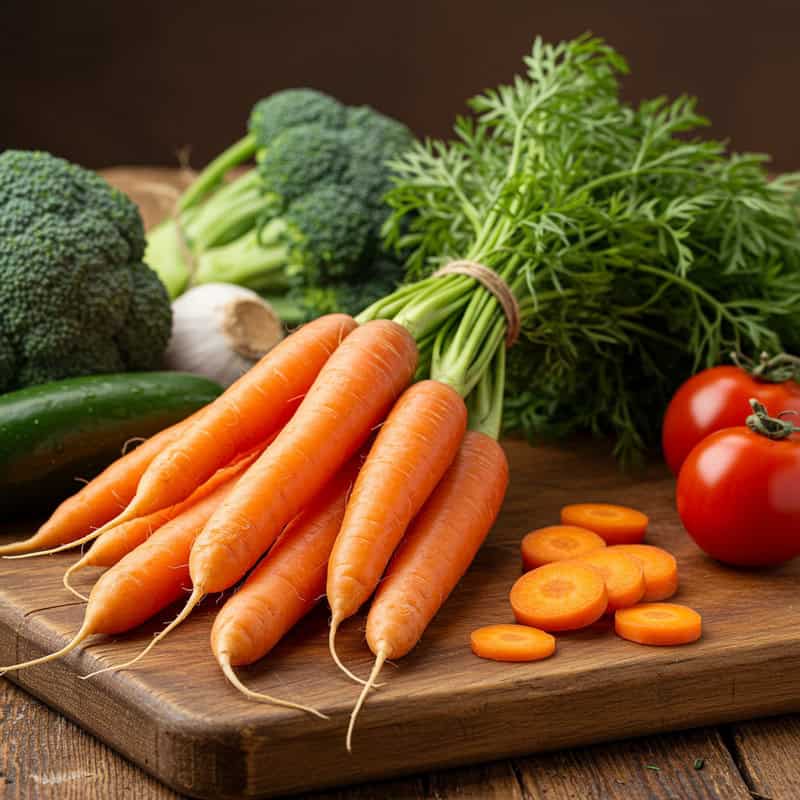
Carrots are a widely enjoyed root vegetable, valued for their high beta-carotene content. Beta-carotene is a powerful antioxidant that the body converts into vitamin A, essential for immune function, skin health, and reducing inflammation by protecting cells from oxidative stress (source). Carrots also contain other phytonutrients and a modest amount of fiber, which contribute to overall health and help regulate inflammatory processes.
When compared to sweet potatoes, carrots offer a similar anti-inflammatory profile due to their beta-carotene content, though sweet potatoes generally provide slightly higher amounts and also deliver more fiber and potassium. Both vegetables are excellent sources of antioxidants, but carrots are especially convenient as a raw snack and are lower in calories, making them a versatile choice for everyday eating (source).
Carrots can be enjoyed both raw and cooked. Eating them raw preserves vitamin C and offers a crisp, refreshing crunch, while lightly steaming or roasting carrots enhances the bioavailability of beta-carotene. For best results, pair carrots with a healthy fat like olive oil or avocado to boost absorption of fat-soluble vitamins.
34. Lentils
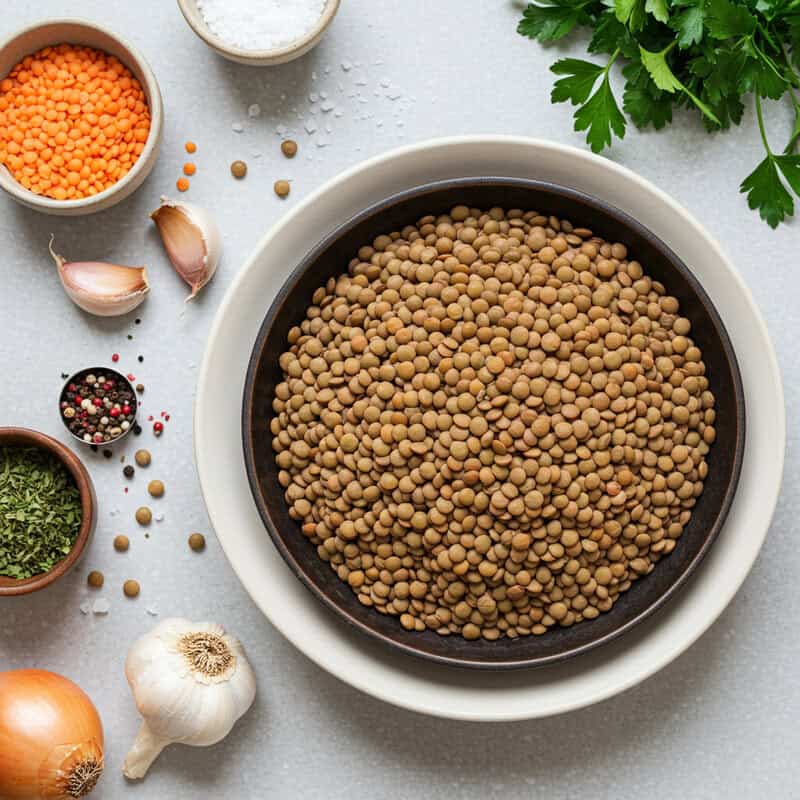
Lentils are a highly nutritious legume, packed with polyphenols—plant compounds with strong antioxidant and anti-inflammatory effects. Polyphenols in lentils help combat oxidative stress and support immune health, playing a significant role in lowering inflammation-related disease risk (source). Lentils are also an excellent plant-based source of protein, making them ideal for vegetarians and anyone seeking to reduce their intake of animal proteins without sacrificing nutrition.
Compared to chickpeas, lentils generally cook faster and provide slightly more protein and dietary fiber per serving. While chickpeas offer a creamy texture and are rich in manganese and folate, lentils are especially notable for their high polyphenol content and versatile use in a variety of dishes. Both legumes are excellent choices for an anti-inflammatory diet, but lentils stand out for quick preparation and a robust nutrient profile (source).
For optimal digestion and nutrient absorption, soak lentils in water for a few hours or overnight before cooking. Rinse them thoroughly to remove any debris. Lentils do not require as much soaking as other legumes and cook quickly. Use them in soups, stews, salads, or curries for an anti-inflammatory, protein-rich meal.
35. Walnuts
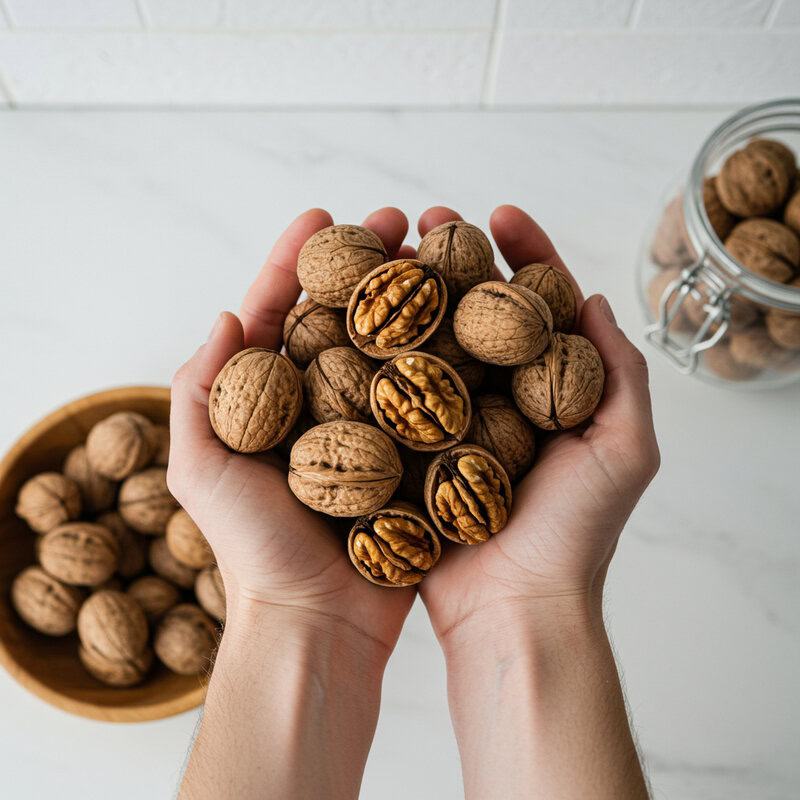
As previously noted, walnuts are a top plant-based source of alpha-linolenic acid (ALA), but their anti-inflammatory benefits extend beyond omega-3s. Walnuts are also rich in polyphenols, including ellagitannins, which gut bacteria convert into urolithins—compounds shown to reduce inflammation and oxidative stress at the cellular level (source). This dual action of healthy fats and polyphenols positions walnuts as a uniquely protective food for heart, brain, and metabolic health.
Incorporating walnuts creatively into your diet can help maximize their benefits. Try blending walnuts into sauces or dips like walnut pesto, using ground walnuts as a crust for baked fish or chicken, or sprinkling chopped walnuts over roasted vegetables for extra crunch and nutrition. They also make a great addition to baked goods, such as banana bread or energy bars, and can be soaked and blended into walnut “milk” for smoothies or coffee. For a savory twist, toast walnuts with spices like smoked paprika or cumin and add to grain bowls or salads. These diverse applications ensure you enjoy the anti-inflammatory properties of walnuts in both sweet and savory dishes.
36. Seaweed

Seaweed is a nutrient-rich marine vegetable that offers unique anti-inflammatory benefits, primarily due to its high content of fucoxanthin and iodine. Fucoxanthin is a marine carotenoid with potent antioxidant and anti-inflammatory properties, shown to suppress inflammatory markers and protect cells from oxidative damage (source). Iodine is essential for healthy thyroid function, which plays a key role in regulating metabolism and the body’s inflammatory response.
Compared to land vegetables, seaweed stands out for its mineral density, especially its high iodine, calcium, and magnesium content. While land vegetables like spinach or kale are rich in vitamins and certain antioxidants, they do not provide the same levels of unique marine compounds or essential trace minerals found in seaweed. This makes seaweed a valuable addition to an anti-inflammatory diet, particularly for those who may not consume enough minerals from other sources (source).
Enjoy seaweed in a variety of ways: use nori sheets to make sushi rolls, add wakame or dulse to salads, or sprinkle dried seaweed flakes on soups, grains, and popcorn. Seaweed salads with sesame oil and vinegar are a flavorful and convenient way to benefit from its anti-inflammatory properties.
37. Black Pepper

Black pepper is more than just a common seasoning—it’s a powerful ally in anti-inflammatory cooking, thanks to its active compound piperine. Piperine not only has its own mild anti-inflammatory properties but is especially valued for its synergistic effect with turmeric. It dramatically increases the bioavailability of curcumin, turmeric’s main active ingredient, by inhibiting certain enzymes that would otherwise break down curcumin before it can be absorbed (source). This combination enhances the anti-inflammatory and antioxidant effects of both spices when used together.
Compared to other spices such as cayenne, cinnamon, or cumin, black pepper’s main advantage is its ability to boost the efficacy of other anti-inflammatory compounds. While those spices possess their own health benefits, none have shown the specific absorption-enhancing power of piperine (source).
For best results, add freshly ground black pepper to dishes at the end of cooking to preserve its aromatic oils. Use it alongside turmeric in soups, stews, curries, or golden milk. Sprinkle black pepper on salads, eggs, or roasted vegetables to enhance both flavor and nutrient absorption, making it a staple in any anti-inflammatory kitchen.
38. Tofu
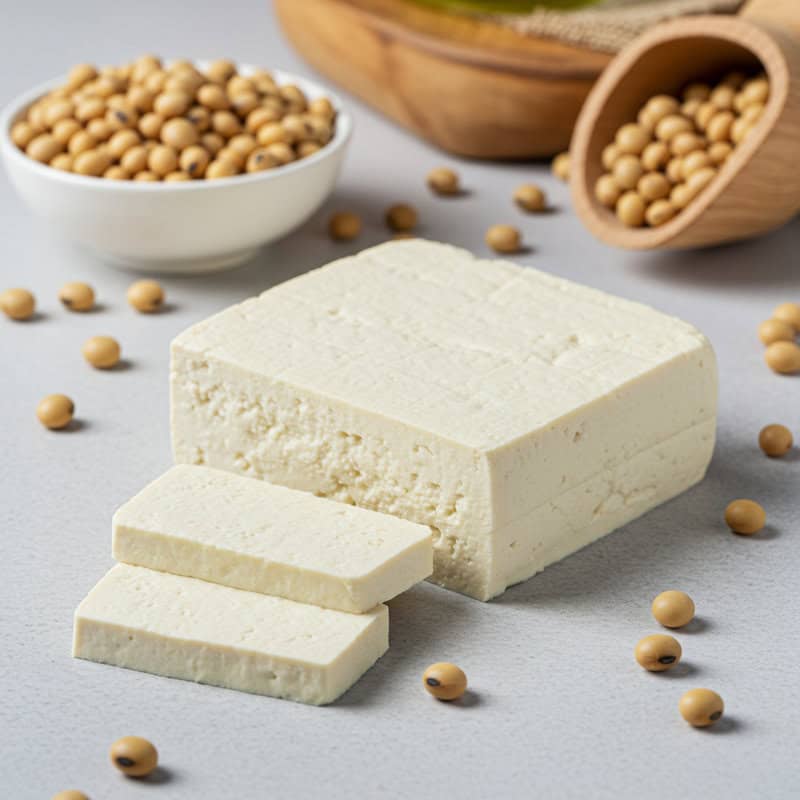
Tofu, made from soybeans, is a versatile plant-based protein that offers notable anti-inflammatory benefits. Its primary active compounds, known as isoflavones, have been shown to modulate inflammatory pathways and reduce the risk of chronic diseases such as cardiovascular disease and certain cancers (source). Isoflavones act as phytoestrogens, providing antioxidant effects and helping to lower levels of inflammatory markers in the body.
When compared to tempeh—another soy-based protein—both foods provide isoflavones, but tempeh undergoes fermentation, which increases its digestibility, nutrient availability, and probiotic content. While tofu is softer and more neutral in flavor, making it suitable for a wide range of recipes, tempeh offers a firmer texture and nuttier taste. Both are excellent additions to an anti-inflammatory diet, but tempeh may offer additional gut health benefits due to fermentation (source).
To get the most from tofu, use gentle cooking methods such as steaming, sautéing, or baking to preserve its nutrients. Marinate tofu for added flavor, then add to stir-fries, salads, or grain bowls. For a crispier texture, press tofu before cooking to remove excess moisture and pan-fry or roast until golden.
39. Pineapple

Pineapple is a tropical fruit best known for its high content of bromelain, a powerful enzyme with anti-inflammatory and digestive benefits. Bromelain works by breaking down proteins and modulating inflammatory pathways, making it effective for reducing swelling, easing joint pain, and supporting recovery after exercise or injury (source). Studies have shown that bromelain can help lower levels of inflammatory markers and may be beneficial for those with arthritis or sinus inflammation.
Papaya, another tropical fruit, contains papain—an enzyme with similar properties to bromelain. Both enzymes aid digestion and exhibit anti-inflammatory effects, but bromelain is generally considered more potent in reducing inflammation, particularly when consumed fresh. While papaya offers additional antioxidants like beta-carotene, pineapple’s bromelain content makes it a standout choice for inflammation support (source).
For best results, enjoy pineapple fresh, as cooking can destroy much of its bromelain activity. Slice pineapple into chunks for snacking, add to fruit salads, blend into smoothies, or use as a topping for yogurt or grilled dishes. Pairing pineapple with spicy or savory foods can enhance its flavor while delivering anti-inflammatory benefits.
40. Cabbage
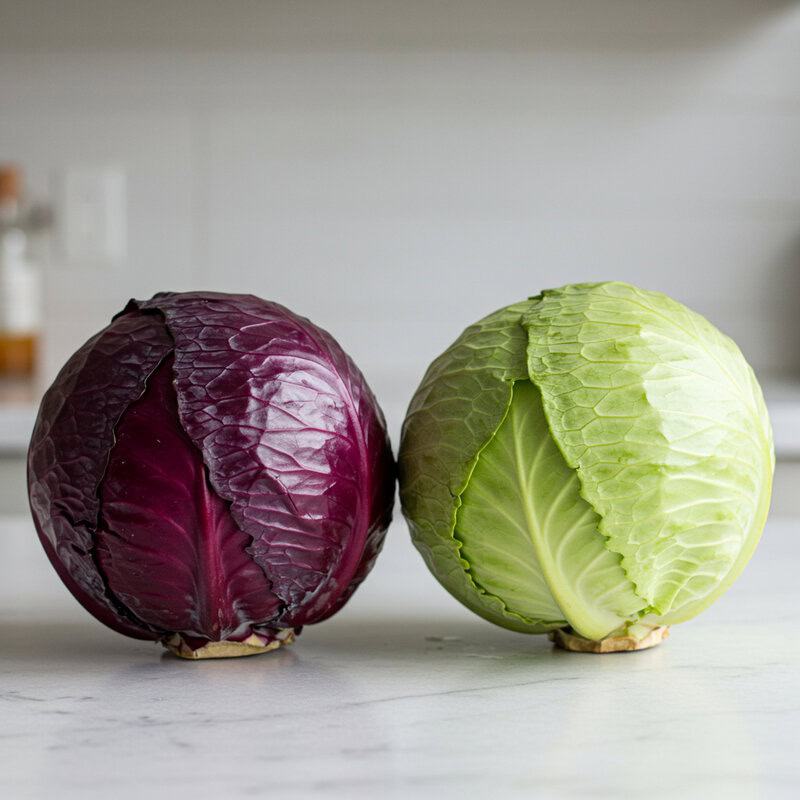
Cabbage is a cruciferous vegetable packed with anthocyanins and vitamin C, both of which contribute to its anti-inflammatory and antioxidant effects. Anthocyanins are plant pigments found primarily in red and purple cabbage that help neutralize free radicals and suppress inflammation in the body (source). Vitamin C further boosts immune function and reduces oxidative stress, making cabbage an excellent addition to an anti-inflammatory diet.
When comparing red and green cabbage, red cabbage stands out for its higher anthocyanin content, giving it a stronger anti-inflammatory profile and deeper color. Green cabbage, while lower in anthocyanins, still provides significant amounts of vitamin C and fiber. Both varieties offer glucosinolates, compounds unique to cruciferous vegetables that support cellular health and may help prevent inflammation-related diseases (source).
For a nutritious and refreshing way to enjoy cabbage, try making coleslaw. Shred red or green cabbage and toss with carrots, apple, a squeeze of lemon, and a light vinaigrette or yogurt-based dressing. This raw preparation preserves vitamin C and maximizes the vegetable’s crisp texture and health benefits, making it perfect for salads, wraps, or as a side dish.
41. Sunflower Seeds

Sunflower seeds are a nutrient-dense snack, particularly valued for their high vitamin E and selenium content. Vitamin E acts as a powerful antioxidant, protecting cells from damage and helping to regulate inflammation in the body. Selenium, a trace mineral, supports immune function and further reduces oxidative stress, making sunflower seeds an excellent choice for anti-inflammatory diets (source). Regular consumption has been linked to better cardiovascular health and improved immune response.
Compared to pumpkin seeds, sunflower seeds are especially rich in vitamin E, while pumpkin seeds offer more magnesium and zinc. Both seeds provide healthy fats, fiber, and plant-based protein, but sunflower seeds are particularly effective for boosting antioxidant defenses and supporting skin and cell health. Choosing a mix of both seeds can help round out your nutrient intake (source).
Sunflower seeds make a satisfying snack on their own—enjoy them raw or lightly roasted for extra crunch. Sprinkle them over salads, yogurt, or oatmeal for added texture and nutrition. You can also blend sunflower seeds into homemade granola bars, trail mixes, or use sunflower seed butter as an alternative to peanut butter in sandwiches and smoothies.
42. Apple Cider Vinegar

Apple cider vinegar (ACV) is a fermented liquid made from crushed apples, known for its acetic acid content and polyphenols. Acetic acid has been shown to help regulate blood sugar, support healthy gut bacteria, and reduce certain markers of inflammation (source). The polyphenols naturally present in apples contribute additional antioxidant effects, helping to combat oxidative stress and support overall immune health.
Compared to other vinegars, such as white or balsamic vinegar, ACV contains more bioactive plant compounds and often includes the “mother”—a mix of enzymes, proteins, and beneficial bacteria formed during fermentation. While all vinegars offer some antimicrobial and antioxidant benefits, apple cider vinegar is especially popular for its potential anti-inflammatory and probiotic properties (source).
When using ACV, dilute 1-2 tablespoons in a large glass of water before drinking, as the acidity can damage tooth enamel and irritate the digestive tract if consumed undiluted. ACV also works well in salad dressings, marinades, or added to sauces. Always consult your doctor if you have chronic health conditions or take medications, as ACV may interact with certain treatments.
43. Edamame

Edamame, or young green soybeans, are a popular anti-inflammatory food thanks to their impressive plant protein and folate content. Edamame provides all nine essential amino acids, making it a complete protein source ideal for vegetarians and vegans. The folate in edamame supports cellular repair, DNA synthesis, and healthy immune function, all of which are important for keeping inflammation in check (source). Edamame also contains isoflavones, plant compounds that have been shown to lower inflammatory markers and support heart health.
When compared to mature soybeans, edamame is lower in fat and calories but higher in certain vitamins and minerals, such as vitamin K and folate. Mature soybeans are used to produce tofu, tempeh, and soy milk, and while they are also nutritious, edamame offers a fresher taste and softer texture. Both forms of soybean provide anti-inflammatory benefits, but edamame is especially prized for its convenience and flavor (source).
Edamame is easy to prepare—simply steam or boil the pods for a few minutes, sprinkle with sea salt, and enjoy as a snack or appetizer. Shelled edamame can be tossed into salads, grain bowls, or stir-fries, or blended into dips for a protein-rich, anti-inflammatory boost.
44. Strawberries

Strawberries are a delicious and nutrient-rich fruit, renowned for their high vitamin C and ellagic acid content. Vitamin C acts as a powerful antioxidant, helping to neutralize free radicals and reduce inflammation, while ellagic acid is a polyphenol that has demonstrated anti-inflammatory and cancer-preventive properties in scientific studies (source). Regular consumption of strawberries has been associated with lower levels of inflammatory markers and improved cardiovascular health.
When compared to other berries, such as blueberries and raspberries, strawberries stand out for their particularly high vitamin C content, providing more than 100% of the daily recommended value in just one cup. While all berries deliver valuable antioxidants and polyphenols, the specific combination of vitamin C and ellagic acid in strawberries makes them uniquely effective in supporting the immune system and combating inflammation (source).
Enjoy strawberries fresh as a snack, sliced onto oatmeal or yogurt, or blended into smoothies for a naturally sweet, anti-inflammatory boost. You can also add them to salads, desserts, or homemade jams for a burst of flavor and nutrition. Choose organic strawberries when possible to reduce exposure to pesticide residues.
45. Quinoa

Quinoa is a highly nutritious, gluten-free grain praised for its status as a complete protein, meaning it contains all nine essential amino acids. This makes quinoa an excellent plant-based protein source, supporting tissue repair, muscle health, and immune function—key components in managing inflammation (source). Quinoa also contains saponins, natural plant compounds with antioxidant and anti-inflammatory properties, though they can impart a slightly bitter taste if not rinsed off before cooking.
Compared to rice, quinoa boasts a higher protein and fiber content, as well as more vitamins and minerals, such as magnesium and iron. While rice is a staple carbohydrate in many diets, it lacks the complete amino acid profile and the robust anti-inflammatory benefits that quinoa provides (source). Quinoa’s unique nutrient composition makes it a superior option for those seeking to reduce inflammation and increase nutrient density in their meals.
For best results, rinse quinoa thoroughly under running water to remove saponins before cooking. Simmer one part quinoa with two parts water or broth until the grains become translucent and the germ separates. Use quinoa as a base for salads, bowls, or as a substitute for rice in stir-fries and casseroles.
46. Pears
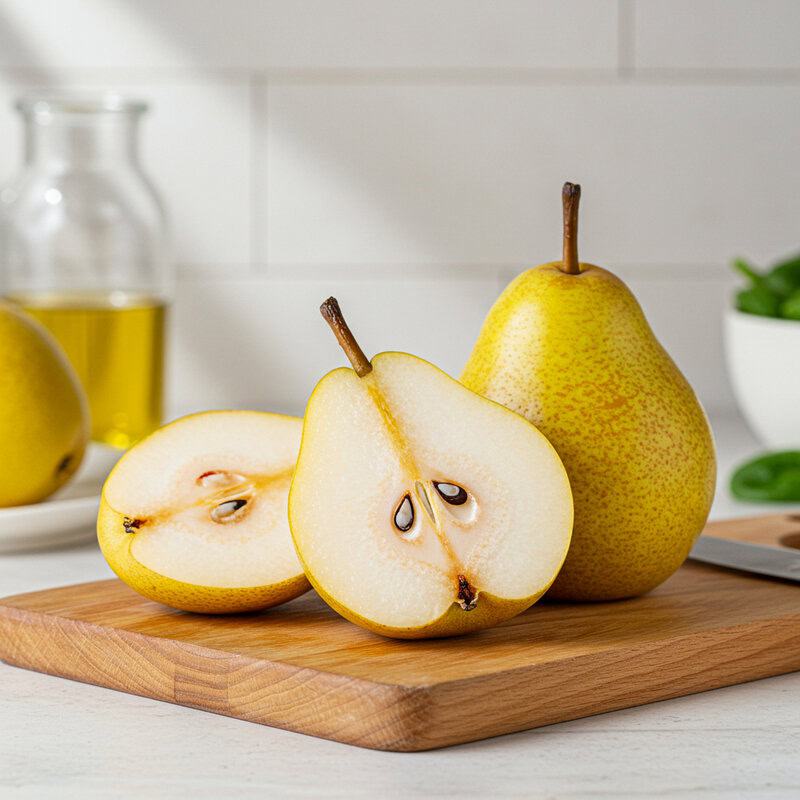
Pears are a sweet, juicy fruit known for their impressive fiber and flavonoid content, both of which contribute to their anti-inflammatory effects. Dietary fiber, especially soluble fiber, supports gut health and helps regulate the immune response by feeding beneficial gut bacteria, which in turn can lower systemic inflammation (source). Pears also contain a variety of flavonoids—plant compounds with antioxidant properties that help protect cells from oxidative stress.
When compared to apples, pears provide a similar range of health benefits, offering slightly more dietary fiber per serving and a different blend of flavonoids. Both fruits are rich in vitamin C and polyphenols, but pears are often gentler on the digestive system due to their softer texture and higher sorbitol content, which can help alleviate constipation (source). The skin of pears, like apples, contains the highest concentration of fiber and antioxidants.
For maximum nutritional benefit, eat pears with the skin on after thoroughly washing. Enjoy them sliced in salads, with cheese and nuts as a snack, or diced into oatmeal and yogurt. Pears also pair well with spices like cinnamon and ginger for a naturally sweet, anti-inflammatory dessert.
47. Brown Rice
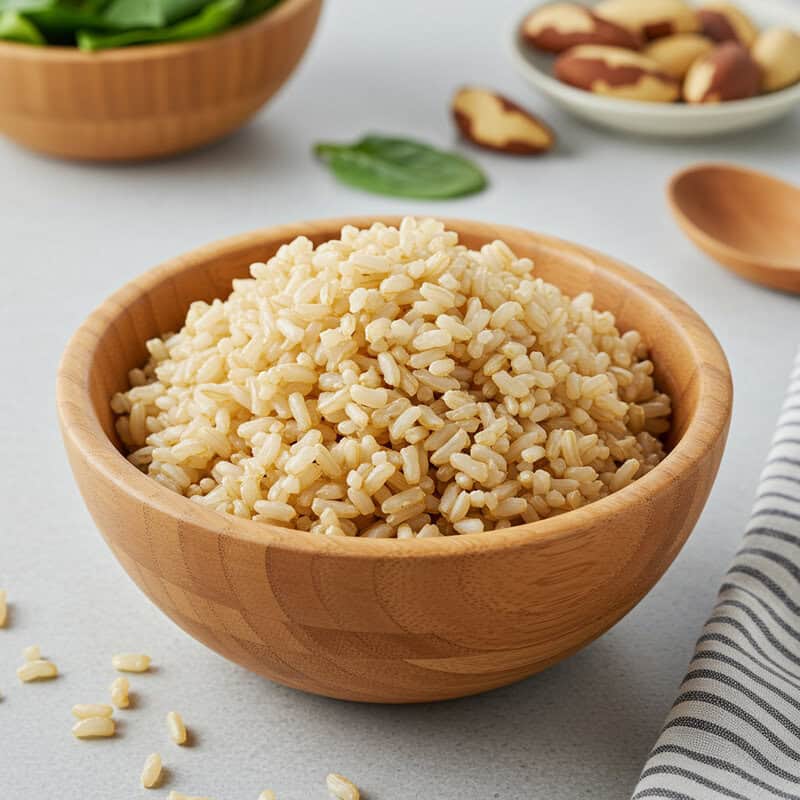
Brown rice is a whole grain celebrated for its magnesium and selenium content, both of which play important roles in reducing inflammation and supporting overall health. Magnesium is essential for hundreds of biochemical reactions, including muscle and nerve function, while also helping regulate inflammatory responses in the body. Selenium acts as a powerful antioxidant, aiding the immune system and protecting cells from oxidative stress (source). Regular consumption of brown rice has been linked to better metabolic health and lower risk of chronic diseases.
When compared to white rice, brown rice retains the nutrient-rich bran and germ layers, offering significantly more fiber, vitamins, and minerals. White rice, due to processing, loses much of these beneficial components and has a higher glycemic index, which can contribute to inflammation over time (source). Brown rice’s slow-digesting carbohydrates also help stabilize blood sugar, further supporting anti-inflammatory goals.
Brown rice is a versatile side dish that pairs well with vegetables, beans, or lean proteins. Try it in stir-fries, grain bowls, stuffed peppers, or as a base for curries and stews. For extra flavor, cook brown rice in low-sodium broth and add herbs or garlic during simmering.
48. Asparagus

Asparagus is a spring vegetable prized for its high levels of glutathione and folate, both of which play vital roles in reducing inflammation and supporting cellular health. Glutathione is often called the “master antioxidant” because it helps neutralize free radicals, detoxify the body, and protect cells from oxidative stress—a key factor in chronic inflammation (source). Folate, a B-vitamin abundant in asparagus, is essential for DNA synthesis and repair, and supports a healthy immune response.
When compared to green beans, asparagus offers higher concentrations of glutathione and folate, giving it a unique anti-inflammatory edge. Green beans are also nutritious, providing fiber, vitamins, and minerals, but asparagus stands out for its antioxidant capacity and its ability to support detoxification pathways (source).
To retain asparagus’s nutrients and delicate flavor, opt for quick cooking methods like roasting or steaming. Toss asparagus spears with olive oil, salt, and pepper, then roast at 425°F (220°C) for 10-15 minutes until tender and lightly browned. Alternatively, steam asparagus for 3-5 minutes and serve with a squeeze of lemon juice or a sprinkle of herbs for a simple, anti-inflammatory side dish.
49. Cacao Nibs

Cacao nibs are small pieces of crushed cacao beans, packed with polyphenols and magnesium that offer impressive anti-inflammatory benefits. Polyphenols in cacao nibs, especially flavonoids, act as powerful antioxidants, reducing oxidative stress and supporting heart and brain health (source). Magnesium, an essential mineral found in abundance in cacao nibs, helps regulate muscle and nerve function, supports a healthy immune system, and contributes to reduced inflammation.
Compared to traditional chocolate bars, cacao nibs are minimally processed and contain no added sugars, dairy, or unhealthy fats. While dark chocolate bars may also provide polyphenols, they often come with extra calories and sugar, which can contribute to inflammation if consumed excessively. Cacao nibs deliver a more concentrated source of antioxidants and minerals in their purest form (source).
For a nutrient boost, sprinkle cacao nibs over smoothie bowls, oatmeal, or yogurt. Their crunchy texture and slightly bitter, chocolatey flavor pair well with fruits, nuts, and seeds. Cacao nibs can also be blended into homemade energy bars or trail mix, offering a satisfying, anti-inflammatory addition to your daily snacks.
50. Miso
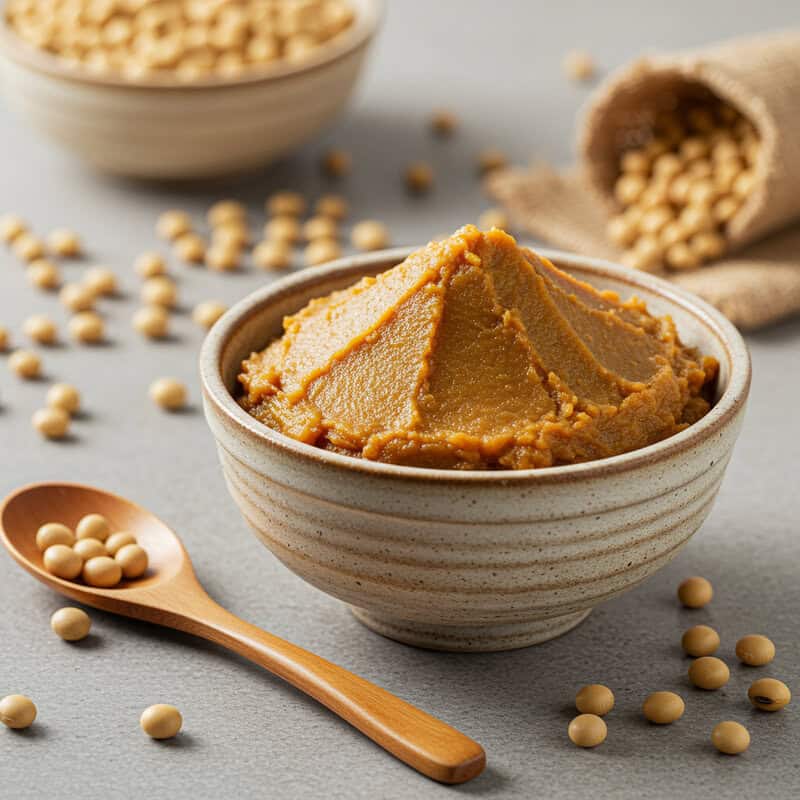
Miso is a traditional Japanese seasoning made from fermented soybeans, renowned for its rich probiotic content and anti-inflammatory benefits. The fermentation process produces beneficial bacteria, or probiotics, which help balance the gut microbiome and support immune function. A healthy gut has been linked to lower levels of systemic inflammation and improved digestion (source). Miso is also a source of bioactive peptides, which can further help modulate inflammatory pathways.
Compared to other fermented foods like sauerkraut, kimchi, or yogurt, miso stands out for its umami flavor and versatility in savory dishes. While all fermented foods offer probiotics that support gut and immune health, miso’s fermentation process also produces unique enzymes and nutrients. It is especially valuable for those seeking plant-based probiotic options (source).
To preserve the beneficial bacteria in miso, avoid boiling it. Add miso paste to soups at the end of cooking, stirring it into warm (not hot) broth. Miso can also be whisked into salad dressings, marinades, or dips for a savory, salty boost. Start with small amounts and increase to taste, as miso is naturally high in sodium.
Conclusion
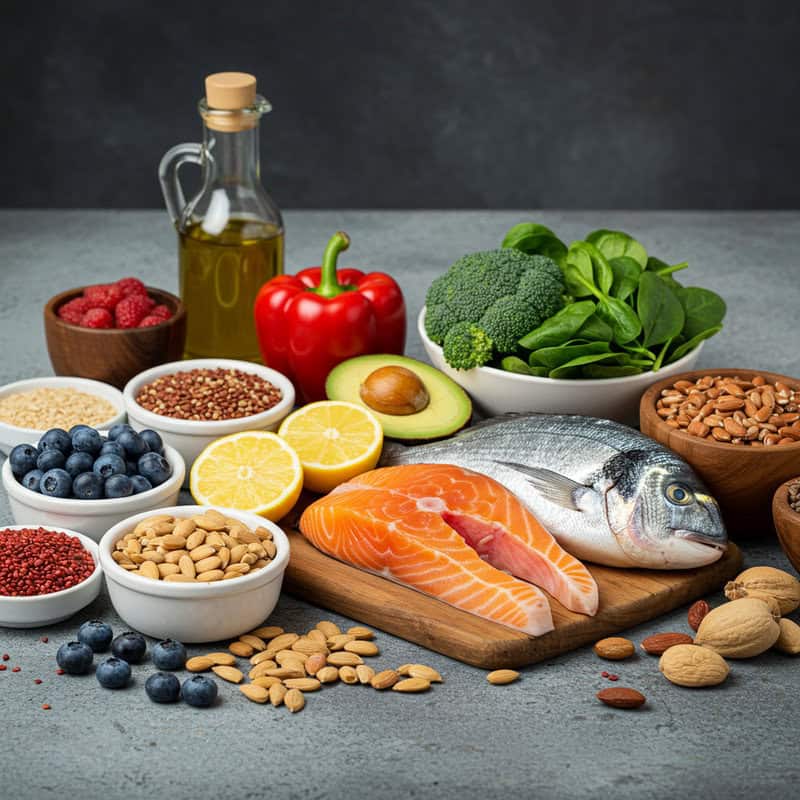
Reducing chronic inflammation is vital for preventing numerous health issues, from heart disease to autoimmune disorders. Incorporating a variety of anti-inflammatory foods into your daily meals can make a significant difference in your overall health and well-being (source). Early dietary changes can help manage inflammation before symptoms become severe. For the best results, consult with a registered dietitian or healthcare professional to receive personalized recommendations tailored to your individual needs and health conditions (source). Taking proactive steps today can lay the foundation for a healthier, more resilient future.
Disclaimer
The information provided in this article is for general informational purposes only. While we strive to keep the information up-to-date and correct, we make no representations or warranties of any kind, express or implied, about the completeness, accuracy, reliability, suitability, or availability with respect to the article or the information, products, services, or related graphics contained in the article for any purpose. Any reliance you place on such information is therefore strictly at your own risk.
In no event will we be liable for any loss or damage including without limitation, indirect or consequential loss or damage, or any loss or damage whatsoever arising from loss of data or profits arising out of, or in connection with, the use of this article.
Through this article you are able to link to other websites which are not under our control. We have no control over the nature, content, and availability of those sites. The inclusion of any links does not necessarily imply a recommendation or endorse the views expressed within them.
Every effort is made to keep the article up and running smoothly. However, we take no responsibility for, and will not be liable for, the article being temporarily unavailable due to technical issues beyond our control.





